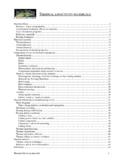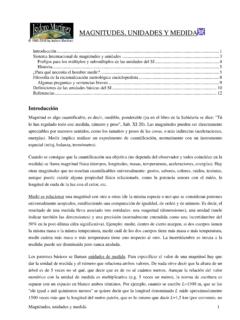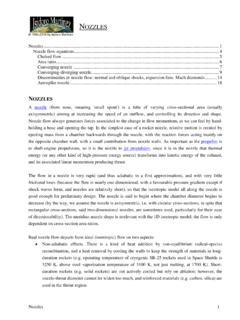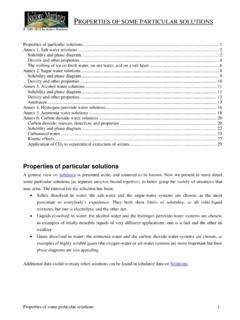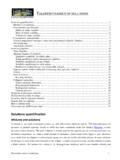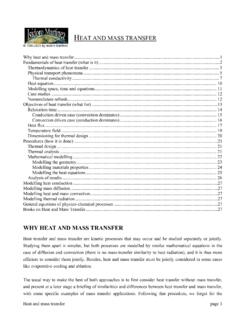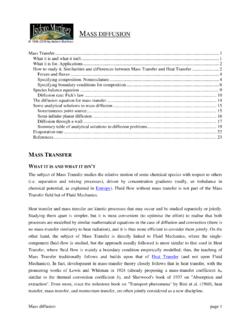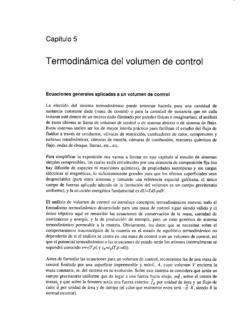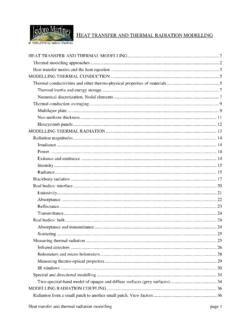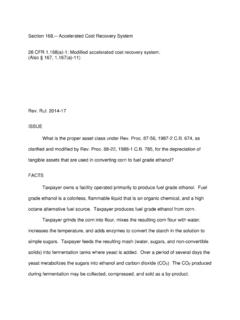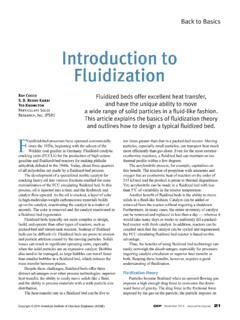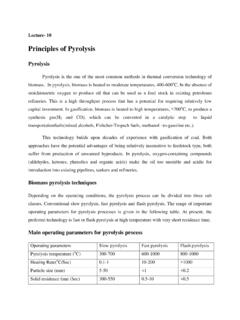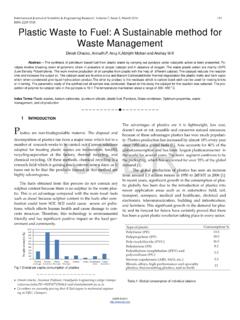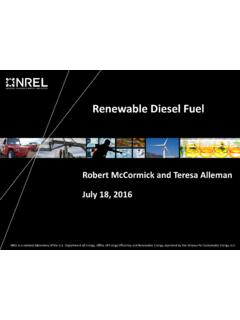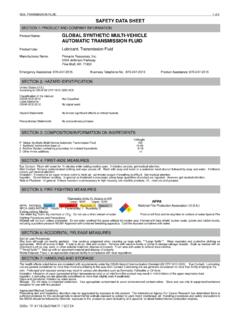Transcription of Fuel properties - UPM
1 Fuel properties 1 FUEL properties Fuel 1 Crude oil .. 2 gasoline .. 2 Bioethanol and ETBE .. 3 Diesel, Kerosene, and Jet fuel .. 4 Jet fuels .. 6 6 Fueloil .. 7 Heavy fueloil .. 7 Natural gas, biogas, LPG and methane hydrates .. 7 Hydrogen .. 10 Production .. 10 Storage & transport .. 12 Safety .. 13 Purity .. 13 Price comparison of hydrogen energy .. 14 Hint: Hydrogen balloon combustion & explosion .. 14 Coal .. 14 Origin .. 14 Types .. 15 Uses .. 15 Composition: proximate analysis and ultimate analysis .. 16 Air requirement for theoretical combustion .. 17 Heating values.
2 17 Wood .. 18 Composition .. 18 Biomass .. 19 Fuel pyrolysis .. 20 FUEL properties Fuels, as for any other type of substance, can be assigned some physical and chemical properties ( density, thermal capacity, vapour pressure, chemical formula, etc. However, most of the times, combustion properties are also assigned to fuels, in spite of the fact that these properties depend on the oxidiser ( air, pure oxygen) and the actual process ( the explosion limits depend on the boundary conditions for a given fuel/oxidiser pair).)
3 Fuel price, availability, risk, and so on, could also be considered fuel properties (attributes). An introduction on fuels and fuel types, including some relevant properties , can be found apart in Fuel consumption and Pyrotechnics are also covered separately. A summary table of fuel properties for normal combustion in air can also be found there. What follows is just a collection of additional notes, mainly physicochemical data, on particular fuels. Fuel properties 2 CRUDE OIL Crude oil is not used directly as a fuel but as a feedstuff for the petrochemical factories to produce commercial fuels, synthetic rubbers, plastics, and additional chemicals.
4 Oil refineries were originally placed near the oil fields, in part because natural gas, which could not then be economically transported long distances, was available to fuel the highly energy-intensive refining process, but since 1950, for strategic reasons crude oil was transported by tankers and oleoducts to local refineries. Most data are highly variable with crude-oil field; typical ranges are given. Density. Typically 900 kg/m3 (from 700 kg/m3 to 1000 kg/m3 at 20 C; floats on water). Linear temperature variation fit. The density of spilled oil will also increase with time, as the more volatile (and less dense) components are lost, so that, after considerable evaporation, the density of some crude oils may increase enough for the oils to sink below the water surface.
5 Freezing and boiling points. When heating at 100 kPa a frozen crude-oil sample (from below 210 K), solid-liquid equilibrium may exist in the range 210 K to 280 K, and liquid-vapour above 280 K; vapours start to decompose at about 900 K. Viscosity=5 10-6 m2/s at 20 C. Exponential temperature variation fit. Pour point= C. Vapour pressure. kPa at 20 C ( kPa at 38 C). Vapours are heavier than air (2 to 3 times). The characteristic time for evaporation of crude-oil spills at sea is 1 day (25% in volume evaporated). Composition. Each crude-oil field has a different composition, that can be established by a combination of gas-chromatography, fluorescence-spectroscopy and infrared-spectroscopy techniques, and that may be used, for instance, in forensic analysis of oil spills at sea (even after refining, crude-oil derivatives may be associated to their source field).
6 Saturated hydrocarbons content is around 60%wt, aromatics 30%wt, resins 5%wt. Sulfur content is Heavy metals <100 ppm. Crude-oil vapours are mainly short-chain hydrocarbons (only about 10% in volume have more than 4 carbons). Flash-point and autoignition temperature: some 230 K and 700 K approximately. Ignition limits: lower , upper Organoleptic: black, brown or dark-green colour, aromatic or sulphide odour. Solubility. < , due mainly to volatile compounds. Surface tension: N/m with its vapours, N/m with water. Price: for a 100 $/barrel (very variable), with 159 L/barrel it is $/L, and with 900 kg/m3 and 42 GJ/toe, it is $/GJ.
7 gasoline Types. In EU: Eurosuper-95, Eurosuper-98 (both lead-free). In the USA: Regular (97 RON) and Premium (95 RON). Density=750 kg/m3 (from 720 kg/m3 to 760 kg/m3 at 20 C). Thermal expansion coefficient=900 10-6 K-1 (automatic temperature compensation for volume metered fuels is mandatory in some countries). Boiling and solidification points. Not well defined because they are mixtures. ( when heating a previously subcooled sample at constant standard pressure, some 10% in weight of gasoline is in the vapour state at 300 K, and some 90% when at 440 K).
8 Viscosity= 10-6 m2/s at 20 C. Fuel properties 3 Vapour pressure. kPa at 20 C, typically 70 kPa at 20 C. Heating value. Average Eurosuper values are: HHV= MJ/kg, LHV= MJ/kg. Theoretical air/fuel ratio: A= kg air by kg fuel. Octane number (RON)= This is a measure of autoignition resistance in a spark-ignition engine, being the volume percentage of iso-octane in a iso-octane / n-heptane mixture having the same anti-knocking characteristic when tested in a variable-compression-ratio engine. Cetane number= , meaning that gasoline has a relative large time-lag between injection in hot air and autoignition, although this is irrelevant in typical gasoline applications (spark ignition).
9 Composition. gasoline composition has changed in parallel with SI-engine development. Lead tetraethyl, Pb(C2H5)4, a colourless oily insoluble liquid, was used as an additive from 1950 to 1995, in some grams of lead per litre, to prevent knocking; sulfur was removed at that time because it inhibited the octane-enhancing effect of the tetraethyl lead. Its typical hydrocarbon composition is presented in Table 1. Average molar mass is M= kg/mol, and ultimate analysis (by weight; see coal analysis below for more details): 87%C and 13%H (corresponds roughly to ).
10 Table 1. gasoline composition*. 60% saturated ( -C-) (is increasing) 15% lineal (n-) 30% branched (iso-) 15% cycle best combustion, low RON high RON 40% unsaturated ( -C-) (is decreasing) 5% olefins (alkenes) 35% aromatics (benzenes) bad smell toxic, yield soot, high RON <500 ppm Sulfur in 2000 <100 ppm Sulfur for 2005 *A sample showed 21% cycle-hexane, 17% iso-octane, 16% iso-pentane, 16% ethyl-bencene, 15% toluene, 12% n-decane, 3% naphthalene, and all other <1%. Solubility in water depends on the actual compounds: hydrocarbons are very insoluble in water, but alcohols readily mix.
